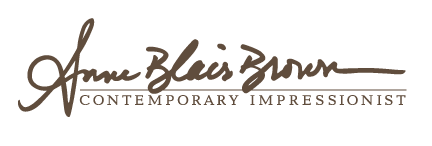I recently presented a demo for Art School Live with Eric Rhoads. The theme was how to loosen up with the added benefit of using Acrylics. This fast-drying medium definitely helps with spontaneous painting, because you can correct mistakes easily and build paint immediately…no slip sliding away! We can achieve an Alla Prima paintings with oils, too, but it’s a little trickier with wet-in-wet. As an aside, I have not switched completely to acrylic paints, but rather have integrated them into my oil painting practice. Sometimes I use them for an underpainting and then go over them with oils later, or sometimes the Acrylic underpainting tells me to stay all Acrylic. Helps me paint larger. With the right surface, paint brand, and brushes, they can look quite a lot like oils.
In the Art School Live demo I started simply with light and shadow shapes, using a sort of Notan sketch as a guide. The concept of Notan (balance of dark & light) and my preliminary sketching was discussed in the demo but not shown on the Live session, so I want to elaborate on that subject as it is a huge part of my loose style. Before I begin a painting, and to familiarize myself with my subject, I do contour drawings, which is simply drawing the outline of the subject in a continuous line (meaning I don’t lift the pencil from the paper). Contour drawings are fluid and imperfect, which loosens me up right out of the gate. Then I take my favorite composition and break it down into 4 values with Greyscale Markers and then in only two values (Notan). This process gets me oriented with my subject which allows me to be more spontaneous when the paint comes into play (I emphasize the word “play”). These preliminary sketches inform my next step, a tonal underpainting or a value “road map”, if you will. Ps, pictures of my sketches and scene reference for the demo painting below.
In the underpainting for the demo and in an effort to keep loose, I used a paper towel to swipe in big shapes with energy and movement. This broad application of massing in shapes informs the end result. The Notan/value underpainting can be graphic or scrubbed in, it doesn’t matter. With a good underpainting, you can pull out information without tight rendering. You are in control to highlight what’s more important, eliminating fussy detail.
I’d like to share some little tricks for looser painting that I mentioned during the demo:
•Use a big brush, a big tattered brush is even better! Use all sides of the brush.
•Lay down a stroke and leave it. You can always adjust it later if it is really a problem, but most of them are not…lay it and leave it.
•Starting with a little controlled chaos will help you stay away from the little fiddle-y details.
•Work all over the canvas, keeping everything at the same level of un-finish. Once you get everything to the same level, anything that needs refining will jump out, and so on and so on until you decide what the final finish is.
•Challenge yourself and see how much information you can leave out and still tell your story. Just because it is there, doesn’t mean you have to put it in.
•Change the colors to suit your needs and work from a limited palette to achieve color harmony. As long as your values are correct, the painting will work.
•If a color is not shining the way you want, what can you do to enhance it? I continually focus on contrast, juxtaposed complements, bold against neutral, and cool next to warm (or layered on top of). If you watch my demo, you’ll see that with each stroke I employed one of these concepts.
My final offering to stay loose is to get a little out of your comfort zone. When I am giving a demo, being recorded giving a demo, or am under any time constraints, I usually do better. While you may not ever be recorded or filmed, you could set a timer knowing you must stop once the timer sounds, at least to step back and check values. Using Acrylics is also a great teacher of expedience because of the quick drying time. Painting outside will also teach you to get that paint down. That light changes fast! I feel that any of the aforementioned constraints train you to be more spontaneous and therefore more painterly. In any case, just remember to stick to those big shapes and big brushes, and have fun!
You can see the demo here https://www.facebook.com/Eric.Rhoads.Publisher/videos/3963678433956792 and here https://www.youtube.com/watch?v=sswddqpKTpU









